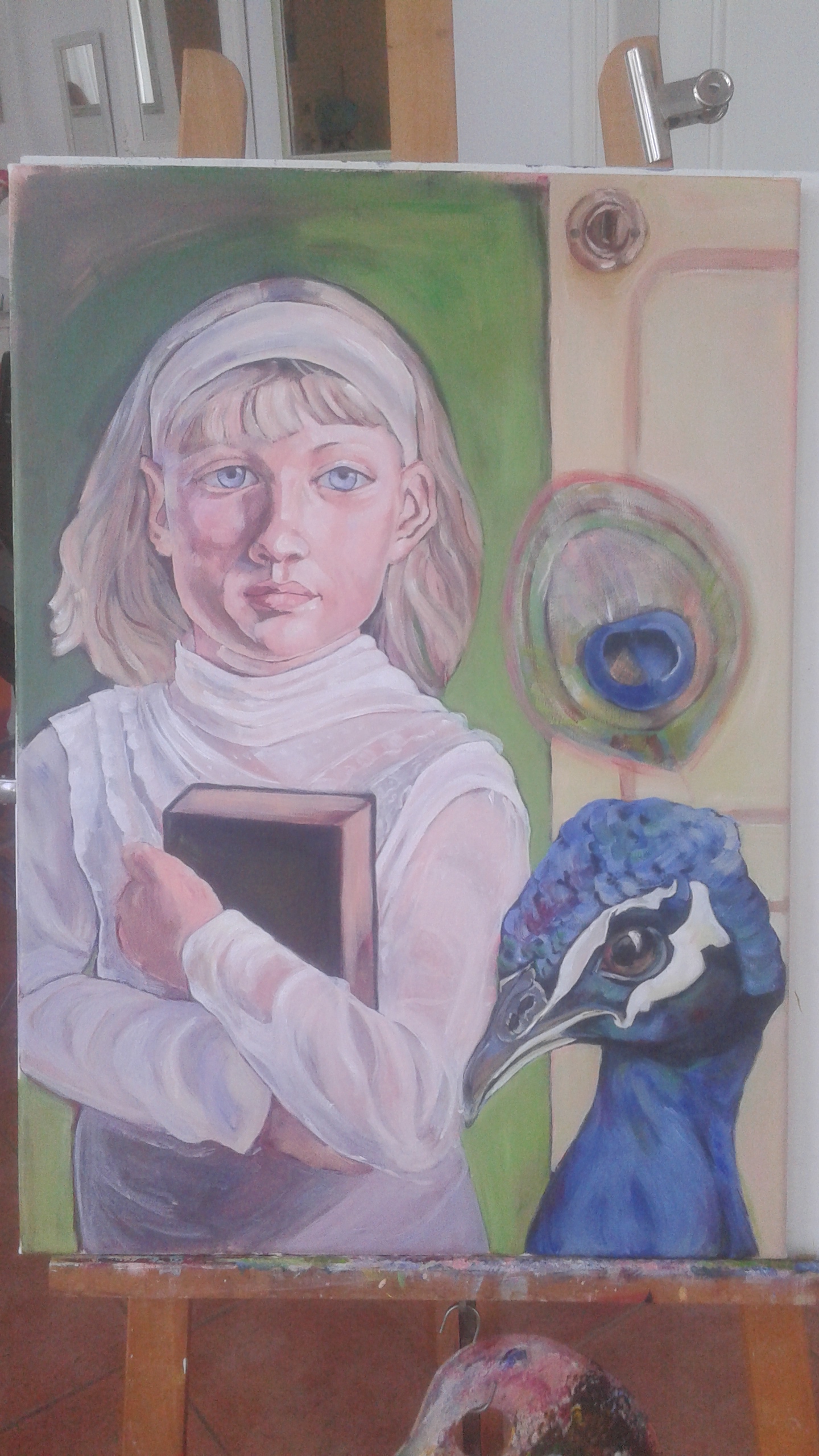Painting in progress
“Θα μας βρει η νύχτα μ’ άσπρα τα μαλλιά, μα τα τραγούδια παιδικά και μελανιές στα πόδια…” Στίχοι του Σταύρου Ρουμελιώτη

I have been painting this last week and so I haven’t got round to writing the third part on relational trauma and healing in connection to narcissism. Instead today I’ve chosen to write a little on dissociation and share a podcast by Rick and Forrest Hanson at: https://www.rickhanson.net/being-well-podcast-how-to-deal-with-dissociation/, in which they talk about many aspects and levels of dissociation, the functions it serves, experiences that can lead to it and how to deal with it. I realised that I haven’t written anything on dissociation for quite some time now, but trauma and dissociation are very closely linked, as Bessel van der Kolk writes “dissociation is the essence of trauma”, and this site is a all about trauma and art. In his book, The Body Keeps the Score: Mind, Brain and Body in the Transformation of Trauma, Bessel van der Kolk writes: “Dissociation is the essence of trauma. The overwhelming experience is split off and fragmented, so that the emotions, sounds, images, thoughts, and physical sensations related to the trauma take on a life of their own. The sensory fragments of memory intrude into the present, where they are literally relived. As long as the trauma is not resolved, the stress hormones that the body secretes to protect itself keep circulating, and the defensive movements and emotional responses keep getting replayed.”
As mammals we have inherent defense mechanisms and capacities to cope with challenging circumstances, which have both positive and problematic aspects. One of these is dissociation. Forrest Hanson introduces the topic by saying that “It’s normal for us to have a relatively continuous experience of reality. This happens so seamlessly that we usually aren’t even aware of it. While it’s normal for our sense of self to grow and change over time, there’s usually a pretty continuous sense of who “you” are that extends in a largely unbroken line into the past. In much the same way, automatic functions like our senses and memory create a continuous experience of the world around us. When this automatic process breaks down, we experience dissociation.” Breuer postulated that “trauma creates fright, which inhibits the flow of ideas, and thereby establishes a hypnoid state – one which is re-established every time there is a collection of the emotionally charged idea. This is very close to modern views of trauma creating dissociative states that are combined with intrusive recollections, or reliving, of the trauma. In the intrusive reliving states, the person may lose contact with present reality, experiencing a past trauma as if it were happening in the present. Current therapies for traumatic stress involve enabling the person to access the distressing recollections, while simultaneously bringing these into contact with present reality” (Valerie Sinason, 2013).
In this podcast the topics discussed are the nature of dissociation; the reasons people dissociate; healthy every day forms of dissociation; dissociation as an adaptive and protective function; dissociation as an experience or coping strategy that lies on a spectrum and the risks of over pathologising; dissociative disorders and vulnerability to zoning out; sense of fragmentation and separation; memory loss of traumatic events and recovery of dissociated memories; implanted memories (false memory syndrome); common symptoms of dissociation; challenges of mindfulness for dissociation; growing resilience and inner resources, self-worth and coming into our own life as an antidote for dissociation; enjoyment as a grounding experience, and finally, the fact that our nature is to move towards association and the importance of creating a coherent narrative about our childhood. They situate themselves, and also provide various examples of experiences that we might be prone to dissociate, in order to protect ourselves. Dr Rick Hanson refers to how 20 years after high school he would experience a mild disconnection when entering meetings with high status or authority figures. More examples are provided of recovery of memories of events that we might have pushed out of sight for decades, like for instance, extreme bullying in (high) school. We could for example recover the memory that we were ganged up on and stuffed into a trash can only once we return to our school or hometown.
I am also sharing a song with the title Memory (Μνήμη), created by Stavros Roumeliotis (στίχοι | μουσική: Σταύρος Ρουμελιώτης), and sung by Maria Papageorgiou (Μαρία Παπαγεωργίου) at: https://www.youtube.com/watch?v=5ahHR9WYSnw
“Θα μας βρει η νύχτα μ’ άσπρα τα μαλλιά, μα τα τραγούδια παιδικά και μελανιές στα πόδια. Θα μας ψάλλει η νύχτα με γέρικη χροιά μα τα τραγούδια παιδικά, ξυράφια για ακόρντα. Το βράδυ η μνήμη δεν αφήνει το νου να κοιμηθεί στην κούνια το σώμα όλο παλεύει να χωθεί ύπουλα παίζει – παίζει ακόμα – παιχνίδια η μνήμη μας. Θα μας βρει η νύχτα μ’ άσπρα τα μαλλιά, μα τα τραγούδια παιδικά – ξυράφια για ακόρντα. Το βράδυ η μνήμη δεν αφήνει το νου να κοιμηθεί, στην κούνια το σώμα όλο παλεύει να χωθεί. Ύπουλα παίζει – παίζει ακόμα – παιχνίδια η μνήμη μας.”
